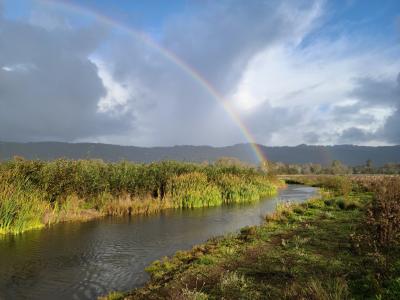Deep Roots — Celebrating 40 Years of Watershed Restoration
April 25 - 28, 2023
Fish Passage Design and Implementation Lessons Learned
27 April 2023
1:30pm - 5:00pm
Session Coordinators:
Jason Q. White, Environmental Science Associates
P. Travis James, Michael Love & Associates
Luke Walton, Prunuske Chatham, Inc.
Jason Q. White, Environmental Science Associates
P. Travis James, Michael Love & Associates
Luke Walton, Prunuske Chatham, Inc.
Fish passage remains a significant issue for salmonids throughout California. Salmonids’ life history strategy to move about and utilize various habitats within a watershed is critical to their survival as a species, particularly in the face of climate change. Barriers that prevent fish movement can break the salmonid life cycle with dire consequences to a population in a given watershed. The California Department of Fish and Wildlife collects barrier data from various agencies and organizations in California and compiles them into the Passage Assessment Database (PAD). The PAD currently lists thousands of total, partial, and temporal barriers in the State in need of removal. The PAD also lists hundreds of barriers that have been remediated. Though there is much work to do when it comes to addressing fish passage in California, many barriers have already been successfully removed, with a wide range of successes and setbacks that can be learned from.
This session focuses on fish passage design and implementation lessons learned. It’s been over 13 years since the release of the Part XII of California Salmonid Stream Habitat Restoration Manual: Fish Passage Design and Implementation. The work that has been performed under the guidance of this manual and beyond has much to offer in the way of lessons learned. This session will cover recent innovations, practical experiences, and challenges encountered in designing and implementing fish passage projects throughout the State of California.
Lesson Learned Constructing a Horizontal Fish Screen at Derby Dam,
Dan Kaler, PE, Farmers Conservation Alliance
Dan Kaler, PE, Farmers Conservation Alliance
Carmel River Reroute and Dam Removal Project: Challenges in Design and Construction of a Step-pool Channel,
Robert Mussetter, Program Manager, Tetra Tech, Inc.
Robert Mussetter, Program Manager, Tetra Tech, Inc.
Mill Creek Fish Passage Project: Design, Construction & Lessons Learned,
Justin Bodell RLA, Landscape Architect, PCI
Justin Bodell RLA, Landscape Architect, PCI
Embrace Change: Combining Engineering and Geomorphic Principles to Design Resilient Fish Passage on San Geronimo Creek,
Jason Q. White, Hydrologist, Environmental Science Associates
Jason Q. White, Hydrologist, Environmental Science Associates
Implementation When Design Cannot Progress Past a Conceptual Level: North Fork Battle Creek Fish Passage Improvement Project,
P. Travis James, P.E., Senior Project Engineer, Michael Love & Associates, Inc.
P. Travis James, P.E., Senior Project Engineer, Michael Love & Associates, Inc.
Beale Lake Dam Removal and Roughened Ramp,
Mark Gard, Senior Hydraulic Engineer, California Department of Fish and Wildlife
Mark Gard, Senior Hydraulic Engineer, California Department of Fish and Wildlife
Final Design, Material Sourcing, and Construction Methods of the Nelson Dam Roughened Channel Fishway,
Michael C. Garello, PE , HDR Engineering, Inc.

